- 1School of Geography and Tourism, Shaanxi Normal University, Xi’an, China
- 2Shaanxi Key Laboratory of Disaster Monitoring and Mechanism Modeling, Baoji University of Arts and Sciences, Baoji, China
Exploring the impacts of anthropogenic factors on vegetation cover and future spatiotemporal trends in vegetation cover change are of great practical significance for sustainable management of the ecological environment. This study used the residual, trend analysis, Hurst index, and geographic detector methods to explore the spatiotemporal trends in the effects of anthropogenic factors on vegetation cover in Guanzhong, China from 2001 to 2018. The contributions of different kinds of anthropogenic factors to vegetation cover were quantitatively decomposed to identify those with the most effect. The main conclusions of the study included: 1) Although there was a positive trend in the effects of anthropogenic factors on vegetation cover from 2001 to 2018, this trend was projected to become negative in the future. This transition was evident in 45.53% of the total study area, mainly distributed in the cities of Baoji, Weinan, and Xianyang. The effects of artificial factors on reversing this deteriorating trend in the region should be noted. 2) The factors with the greatest influences on vegetation cover changes were popular tourist attractions, transportation, and urbanization rates. The influences of various factors on vegetation cover showed temporal variation, driven by societal and economic development, indicating the complexity and diversity of the influences of anthropogenic factors on vegetation cover. 3) Sustainable development should be promoted and the pressure on the ecology resulting from popular tourist attractions, the transportation network, and rapid urbanization should be reduced.
1 Introduction
Changes to vegetation cover constitute an important component of global changes that have occurred over the past half century (Yan et al., 2014; Talukdar et al., 2020). Vegetation indices are the most intuitive method of reflecting the effects of climate change, land surface processes, and global changes on vegetation cover (Yang et al., 2021). Popular tourist attractions, developed transportation networks, rapid urbanization and rapid economic growth have an increasing impact on the ecological environment, which will continue to face new threats and pressures in the future (Bai Z. Y et al., 2019; Zhao et al., 2019). Thus, the quantitative assessment and decomposition of the effects of different anthropogenic factors on vegetation cover can assist in sustainable development.
There have been many past studies on changes in vegetation cover through exploring spatial and temporal changes in the Normalized Difference Vegetation Index (NDVI) (Pinzon and Tucker, 2014; Li G et al., 2019). The gradual increased societal priority placed on ecological and environmental protection has resulted in a focus on the impact of anthropogenic factors on spatial patterns and future changes in vegetation cover (Yi et al., 2014; Ding and Li, 2019; Feng et al., 2021). The results of these studies were useful to guide efforts in preventing and mitigating vegetation cover change and for improvement of the ecological environment. Past studies have shown that vegetation cover change is driven by both natural and anthropogenic factors (Cheng et al., 2015; Chen et al., 2017; Li et al., 2017; Wang J. B et al., 2019). The residual method Xhas been applied in the past to separate the effects of anthropogenic factors on vegetation cover change from those of natural factors (Wei et al., 2014; Cheng et al., 2020; Rong et al., 2019; Wu et al., 2019; Wang J et al., 2019). Among the natural factors affecting vegetation cover, past studies have identified single factors such as temperature, precipitation, and sunshine to be the most dominant (Huang et al., 2012; Mu et al., 2012; Li J. F et al., 2019; Zhang Q et al., 2019). However, changes to vegetation cover occur due to the combined effects of multiple natural factors. Recent studies have shown that the influence of soil moisture factors on changes to vegetation cover far exceed those of any single factor, such as temperature, precipitation, or sunshine (Bai M et al., 2019). Changes to soil moisture occur through the combined effects of temperature, precipitation, soil evapotranspiration, and soil moisture (Wang D. L et al., 2013). Some studies have found that vegetation growth is closely related to seasonal changes in soil moisture, i.e., seasonal peaks and troughs in soil moisture are consistent with the vegetation phenology period (Zhang, 2016). This relationship indicates that soil moisture is an important natural factor affecting vegetation growth. Based on previous studies, this present study attempts to make innovative attempts in two aspects: 1) Selection of the soil moisture factor as the main natural factor affecting changes to vegetation cover. In addition, the residual method was used to strip the natural factors, in order to accurately obtain the anthropogenic effects on vegetation cover. 2) Quantitatively separating the effects of the different anthropogenic factors on vegetation coverage, thereby identifying the contribution rates of different types of anthropogenic factors to vegetation cover change.
The Guanzhong region is in central China and is an important part of the Guantian Economic Zone and the Guanzhong Urban Agglomeration (Guo and li, 2019). Guanzhong is densely populated and is industrially and agriculturally developed, with extensive transportation infrastructure, high per-capita gross domestic product (GDP), and clusters of tourist attractions (Ren, 2015). The continually increasing extent of anthropogenic activities in the region has had both positive and negative effects on the ecological environment. An analysis of the effects of anthropogenic factors on changes to vegetation cover in Guanzhong can be of benefit to the improvement of the environment in Guanzhong (Figure 1)
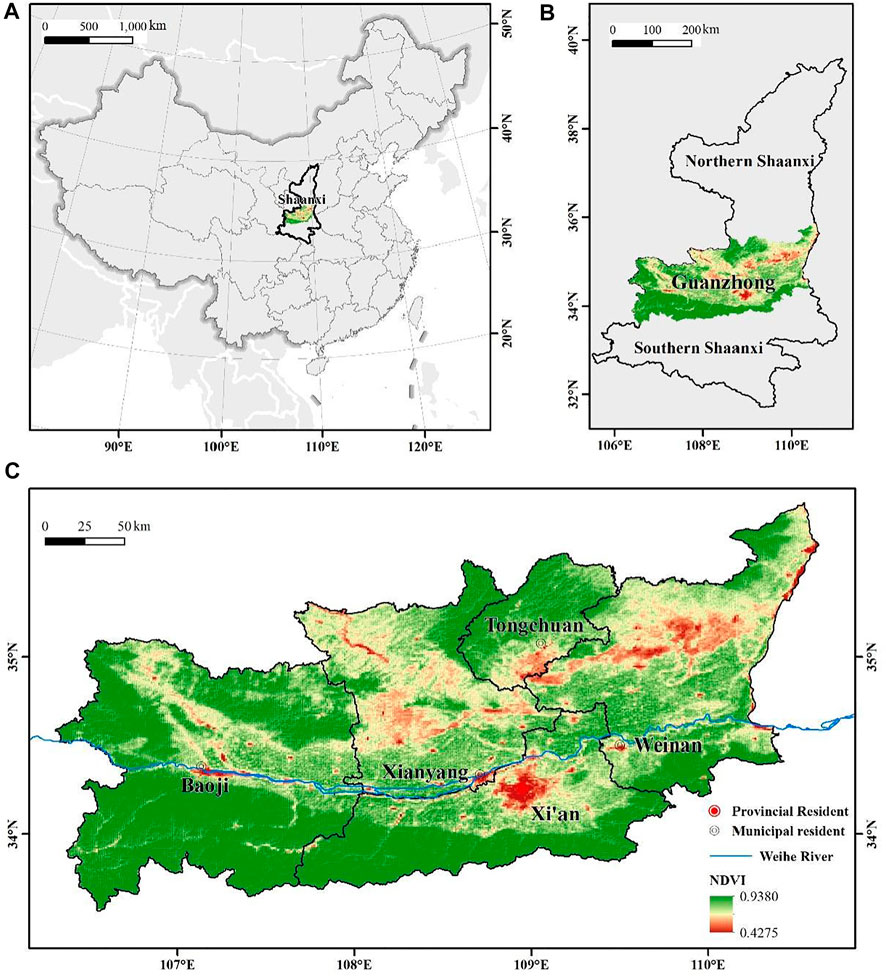
FIGURE 1. Maps of Guanzhong, Central China. (A) the position of Shaanxi Province in Mainland China, (B) the position of Guanzhong in Shaanxi Province, (C) a map of Guanzhong showing the spatial distribution of the Normalized Difference Vegetation Index (NDVI).
Based on the above considerations, the research objectives of the present study were to: 1) analyze the temporal and spatial variations in anthropogenic effects on vegetation cover in the Guanzhong area for the period 2001 to 2018 and to predict future changes; 2) decompose the effects of the multiple different anthropogenic factors on vegetation cover to quantify the contribution of each factor type and to identify the dominant anthropogenic factors; 3) provide an accurate scientific reference for the management of anthropogenic impacts to achieve sustainable development of vegetation in the Guanzhong area.
2 Study Area and Data Sources
2.1 Overview of the Study Area
The Guanzhong area is in central China. Guanzhong is an important part of the Guantian Economic Zone and the Guanzhong Urban Agglomeration and falls in central Shaanxi Province. Guanzhong contains the cities of Xi’an, Baoji, Xianyang, Weinan, and Tongchuan as well as the district of Yangling. The Qinling Mountains (Qinling Daba Mountains) lie to the south, whereas the Loess Plateau, through which the Weihe River flows, lies to the north. There is intense anthropogenic activity in the Weihe River Basin. The area falls within a warm temperate semi-humid climate zone and contains landforms of mainly the Guanzhong Basin type (Bai, 2013). The vegetation coverage in the southern part of the study area exceeds that in the northern part, whereas vegetation coverage in the central part is lower than that in the northern and southern areas.
2.2 Data Sources
The present study obtained data for NDVI from the MOD13A2 dataset of the United States Geological Survey (USGS) network (https://lpdaac.usgs.gov/) with a spatial resolution of 1,000 m. Data for population were obtained from the China Population Distribution Kilometer Grid Dataset of the Resource and Environmental Science Data Center of the Chinese Academy of Sciences (http://www.resdc.cn/). Gross domestic product (GDP) data were obtained from the GDP China Spatial Distribution Kilometer Grid Dataset of the Resource and Environmental Science Data Center of the Chinese Academy of Sciences. Data obtained for the transport network in the study area included national highway, provincial highway, county roads, and railway data. Population data used in the present study included data for residents of the municipal areas of Xi’an, Baoji, Xianyang, Tongchuan, and Weinan, as well as national-level population data. Vector data were obtained from the National Basic Geographic Information Center. Data for the distribution of popular natural tourist attractions were obtained the Department of Culture and Tourism, Shaanxi Province. These data included the 4A- and 5A-level natural tourist attractions, and were for the period prior to January, 2018. Data for rates of urbanization were obtained from statistical yearbooks of cities and counties.
3 Research Method
3.1 Estimation of Soil Moisture
Remote-sensed measures of land surface temperature (LST) and the normalized difference vegetation index (NDVI) have been widely used as estimations of soil moisture (Chen et al., 2014; Mohammadi et al., 2017; Yue and Liu, 2019). In addition, the use of the temperature vegetation dryness index (TVDI) to represent the level of soil moisture offers various advantages, including requiring less input data, simplicity, and a clear biophysical basis within its calculation, and is calculated as (Zhang et al., 2018):
In Eq. 1, Ts is the surface temperature of each pixel and Tsmin and Tsmax are the surface temperatures of the wet and dry sides of the trapezoidal space, respectively. TVDI ranges between 0 and 1 and is inversely related to soil moisture.
3.2 Residual Analysis
The residual method was used to isolate the effects of anthropogenic factors on vegetation cover from those of natural factors. This method has been widely used in the field of geosciences (Huang, 2012; Zhang, 2016). During implementation of the method, inter-annual NDVI and inter-annual TVDI are used as the dependent and independent variables within regression analysis, respectively. The established regression equation predicts the NDVI, and this predicted NDVI is subtracted from the measured NDVI. The differences is then analyzed through trend analysis (residual analysis). The identified trend reflects the impact of anthropogenic effects (residuals) on vegetation coverage. The expression is as follows:
3.3 Trend Analysis
Sen’s trend analysis (Wang S et al., 2013; Su et al., 2019) was used to analyze the spatial trends in anthropogenic effects on vegetation cover in Guanzhong:
In Eq. 3, xj and xi are timeseries data and tj and ti represent periods during the year when Sen >0 and Sen <0, respectively; the former and latter represent positive and negative effects of anthropogenic factors on vegetation cover, respectively.
3.4 Hurst Index
The Hurst index (H) was proposed by British hydrologist Hurst and has been widely used in hydrology, geography, economics, and other fields (Qi et al., 2019; Xu et al., 2019; Zhang S. Q et al., 2019). An 0.5 < H < 1 represents a continuous timeseries, whereas H = 0.5 represents a random sequence timeseries and 0 < H < 0.5 represents a non-continuous timeseries. As shown in Table 1, the spatial distributions of the Sen’s trend and Hurst index were generated to illustrate their changes.
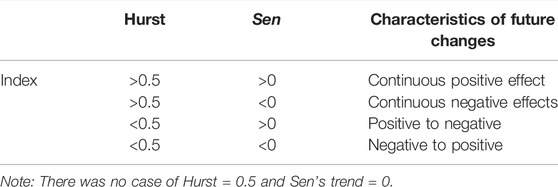
TABLE 1. Sen’s trend and the Hurst index illustrating future changes to vegetation cover by anthropogenic effects.
3.5 Geodetector
The geographic detector quantitative method is used to spatially differentiate phenomena and their driving forces. This method is also used to detect the drivers and underlying mechanisms of the spatial patterns of geographic elements (Wang and Xu, 2017; Huang et al., 2019; Xiao et al., 2021). The factor detector was used to detect the degree of influence of the various anthropogenic factors on vegetation cover and is quantified as Q. The value of Q is positively related to the power of factor X to explain the spatial differentiation of anthropogenic effects on vegetation cover. The q value indicates that a factor X explains 100*q% of the vegetation cover. The process to calculate Q is described in detail in the literature (Wang and Xu, 2017).
The geo-detector model requires the input of continual independent variable data. Therefore, the present study used the ArcGIS natural breakpoint method to convert the six types of artificial factors into continual data, after which the data were reclassified into ten categories (Figure 2). The pre-processed factors were then added to the geo-detector model, and 18 operations (2001–2018) were performed to obtain the influences (contribution rates) of anthropogenic factors on vegetation coverage in each year in the Guanzhong area from 2001 to 2018, expressed as Q in Table 3.
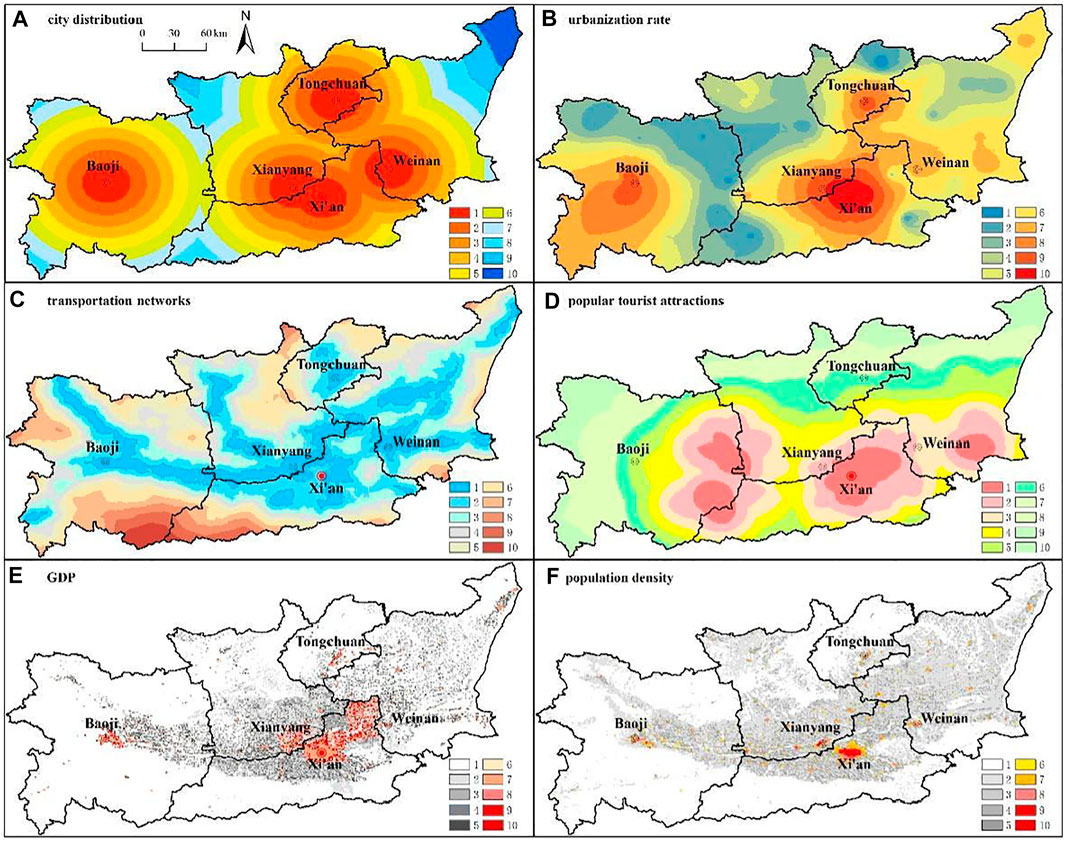
FIGURE 2. Results of reclassification of factor data for Guanzhong, Central China showing distributions of (A) cities, (B) urbanization rate, (C) transportation networks, (D) popular tourist attractions, (E) Gross Domestic Product (GDP), (F) population density.
4 Results
Changes to vegetation cover occur because of the combined effects of natural and anthropogenic factors (Wei et al., 2014). The present study used the residual method to separate the effects of natural factors, represented by the soil moisture factor, on vegetation cover from those of anthropogenic factors.
After isolating the anthropogenic effects on vegetation cover, the temporal and spatial variations in the anthropogenic effects on vegetation cover in Guanzhong for the period 2001 to 2018 were analyzed and future changes were predicted. The effects of the multiple different anthropogenic factors on vegetation cover were then decomposed to quantify the contribution of each type. Finally, the dominant anthropogenic factors were identified. The specific steps followed were as follows:
1) Eqs 1, 2 were applied to 18 years (2001–2018) of NDVI and Temperature Vegetation Dryness Index (TVDI) data and the residual method was used to isolate the effects of anthropogenic factors on vegetation cover from those of natural factors.
2) The temporal changes in the effects of anthropogenic factors on vegetation cover in Guanzhong from 2001 to 2018 were identified (Figure 3) based on regional statistics (mean value).
3) Sen’s trend analysis was applied to the 18 years of changes to vegetation cover in Guanzhong due to anthropogenic effects to identify the trend in spatial change (Figure 4).
4) The Hurst formula was applied to the 18 years of changes in vegetation cover in Guanzhong from 2001 to 2018 due to anthropogenic effects. This allowed the generation of the Hurst distribution of anthropogenic effects on vegetation cover (Figure 5A). The trends in changes to vegetation cover because of anthropogenic factors were superimposed and classified with the results of the Hurst index to identify future trends in effects of anthropogenic factors on vegetation cover (Figure 5B). ArcGIS software was used to generate the statistical summary of future changes in vegetation cover.
5) The anthropogenic factors with dominant effects on vegetation cover were identified. The geo-detector model was applied to identify the influences of various anthropogenic factors on vegetation cover. Six factors, namely population density, GDP, transportation networks, popular tourist attractions, city distribution (prefecture-level), and urbanization rate were selected as the dominant effects of anthropogenic factors on vegetation cover change. These factors were selected through an extensive review of the literature and were based on data for the survey area and their quality.
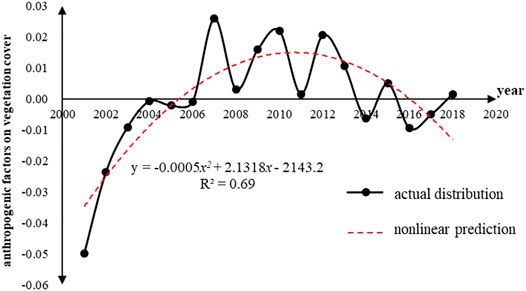
FIGURE 3. Temporal variations in the effects of anthropogenic factors on vegetation cover in Guanzhong, Central China.

FIGURE 4. Spatial variations in the effects of anthropogenic factors on vegetation cover in Guanzhong, Central China.

FIGURE 5. Spatial distributions of anthropogenic effects on vegetation cover in Guanzhong, Central China. (A) Hurst distribution of anthropogenic effects on vegetation cover, (B) future trend in anthropogenic effects on vegetation cover.
4.1 Temporal Changes in Vegetation Cover due to Anthropogenic Factors
As shown in the timeseries of effects of anthropogenic factors on vegetation cover in Guanzhong from 2001 to 2018 (Figure 3), the effects of anthropogenic factors first increased and then decreased, whereas the overall intensity of anthropogenic impacts decreased. The mean effects of anthropogenic impacts on vegetation cover in 2001, 2007, and 2018 were −0.05, 0.03, and 0, respectively. The fastest rate of change in vegetation cover due to anthropogenic effects occurred from 2001 to 2004, after which impacts gradually decreased. The maximum positive effect of anthropogenic factors on vegetation cover occurred in 2007, following which the effect decreased with regular fluctuations. The effects of anthropogenic factors on vegetation cover were once again negative in 2014, although the effects transitioned to positive with fluctuations in 2015 onward.
4.2 Spatial Changes in Vegetation Cover due to Anthropogenic Factors
Around 67.73% of the total area in Guanzhong has experienced a positive change in vegetation cover over the past 18 years (2001–2018) due to anthropogenic factors, whereas a negative change occurred in the remaining area. Negative trends were mainly evident in central Guanzhong in the Weihe River Basin. There were positive trends in vegetation cover in northern and southern Guanzhong. (Figure 4).
4.3 Future Changes in Vegetation Cover due to Anthropogenic Factors
Figure 5A shows the Hurst spatial distribution of the effects of anthropogenic factors on vegetation cover in Guanzhong. Areas of persistent change and anti-persistent change in vegetation cover were widely distributed in Guanzhong, accounting for 35.6 and 64.4% of the total area, respectively. This result indicated that the effects of anthropogenic factors on vegetation cover in Guanzhong are predominantly unsustainable and show a trend that is opposite to that of current development. This assertion is supported by the fact that the area under which there are currently positive effects of anthropogenic factors on vegetation cover will transition to negative effects in the future.
Figure 5B shows the future changes to vegetation cover due to anthropogenic factors. The results show an overall negative trend in the effects of anthropogenic factors on vegetation cover, with areas showing negative and positive trends accounting for 58.92 and 41.08% of the total area, respectively. Combining these results with those of the Hurst distribution (Figure 5A) indicated that the areas showing continuous positive effects on vegetation coverage of anthropogenic factors accounted for 22.20% of the total area. These areas were mainly distributed in northern and southern Guanzhong, with greater positive effects in the north. Areas showing continuous negative effects, accounting for 13.40% of the total area, were distributed along the Weihe River. The areas in which the effects of anthropogenic factors on vegetation transitioned from positive to negative accounted for 45.53% of the total area and were mainly distributed in the cities of Baoji, Weinan, and Xianyang. This result indicated the high likelihood of a similar trend in the future. Therefore, the positive effect of artificial interventions on vegetation should be emphasized to reverse this trend. The areas in which negative effects of anthropogenic factors on vegetation cover transitioned to positive accounted for 18.88% of the total area and were mainly distributed in urban areas and in city center. This result indicates that there is increasing focus on the protection of vegetation in cities (Table 2).
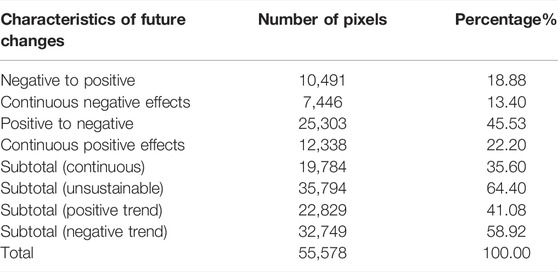
TABLE 2. Statistical table summarizing the future trend in the effects of anthropogenic factors on vegetation cover in Guanzhong, Central China.
Anthropogenic factors are likely to have an overall negative effect on vegetation cover in Guanzhong in the future. Therefore, there should be increasing focus on countering this negative trend in most areas of the cities of Baoji, Weinan, and Xianyang. A comprehensive exploration of the dominant anthropogenic factors affecting vegetation cover can assist in constraining the negative effects of anthropogenic factors on vegetation cover.
4.4 Decomposition of the Different Anthropogenic Factors Affecting Vegetation Cover
There are a wide range of anthropogenic factors that affect vegetation cover. The present study selected six factors from the categories of population, socioeconomic factors, and urbanization levels as the main anthropogenic factors affecting vegetation cover, including: 1) population density; 2) GDP; 3) transportation; 4) popular tourist attractions; 5) prefecture-level distribution, and; 6) urbanization rate. The factor detector module of the geographic detector model was used to identify the contribution of each anthropogenic factor to the effect on vegetation. The contribution of each factor was represented as the Q value, which was visualized using a graded color scale. In the visualization, the value of Q is positively related to the contribution of an anthropogenic factor to the effects on vegetation cover. Table 3 summarizes the results of the factor detection.
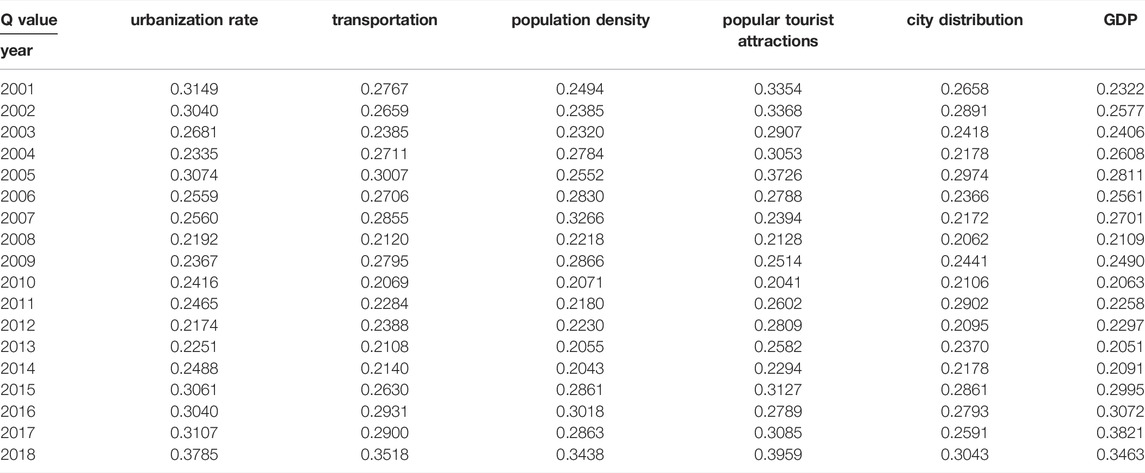
TABLE 3. Effects of different anthropogenic factors on vegetation cover in Guanzhong, Central China from 2001 to 2018 (a summary of Q values).
As shown in Table 3, the main anthropogenic factors affecting vegetation cover in Guanzhong were popular tourist attractions, traffic networks, and urbanization rate. As shown in Figure 6, the Q value did not change as the study period progressed. This indicates that the influence of anthropogenic factors on vegetation cover will not increase over time (the average Q in 2001 exceeded that in 2009).
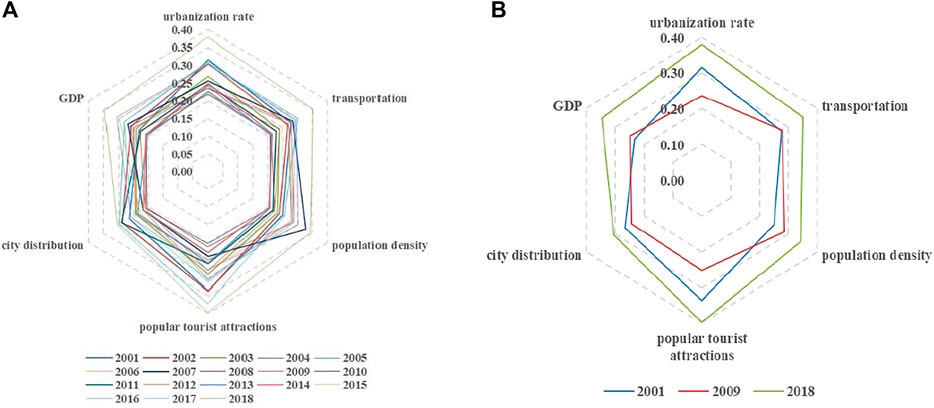
FIGURE 6. Radar distribution of factor Q detection of the effects of different anthropogenic factors on vegetation cover in Guanzhong, Central China. (A) Overall distribution (from 2001 to 2018), (B) Partial distribution (2001, 2009, and 2018).
In summary, the main anthropogenic factors affecting vegetation cover in Guanzhong were found to be popular tourist attractions, traffic networks, and urbanization rate. The effects of each factor on vegetation cover fluctuated over time, showing a certain degree of diversification of social development and complexity of anthropogenic activities.
5 Discussion
5.1 Temporal and Spatial Distribution of Anthropogenic Factors on Vegetation Cover
From the temporal of anthropogenic factors on vegetation cover, these observations highlight the complexity of the influence of anthropogenic factors on vegetation cover, i.e., the positive and negative effects of anthropogenic factors on vegetation cover occur concurrently, resulting in fluctuation impacts. The natural vegetation of Guanzhong has been damaged in recent years by an increased urban population and the associated accelerated urbanization, increase in national GDP, extended transport networks, and frequent visits to tourist attractions. On the other hand, the implementation of various policies has improved the vegetation ecosystem, including grassland construction and afforestation projects (Bai, 2013; Ren, 2015; Zhang et al., 2018; Guo and Li, 2019; Hu et al., 2021). These observations also emphasize the need for increased attention by government and society on the sustainable development of vegetation resources. The study of the temporal variation in the effects of anthropogenic factors on vegetation cover and the decomposition of the effects of different anthropogenic factors can assist in the sustainable development of vegetation resources.
From the spatial distribution of anthropogenic factors on vegetation cover, Central Guanzhong is characterized by a high population density, high GDP, rapid development of urban road networks, a higher number of popular tourist natural areas, and more rapid urbanization rates. These factors result in more intensive anthropogenic activities. The results also indicated that more intensive anthropogenic activities have a greater impact on vegetation cover.
5.2 Decomposition of the Different Anthropogenic Factors Affecting Vegetation Cover
The main anthropogenic factors affecting vegetation cover in Guanzhong were popular tourist attractions, traffic networks, and urbanization rate (Table 3). The main reason may be: Since Guanzhong contains the provincial capital Xi’an, it is the center of material, energy, and information exchange and transformation in the province. In comparison with southern and northern Shaanxi, Guanzhong contains a higher number of popular tourist attractions, a developed transportation network, and a higher urbanization rate. There is often a focus on the scale and quantity of urban development, with less attention on the cost of resources and damage to the environment. This results in increased stress on vegetation.
The influence of anthropogenic factors on vegetation cover will not increase over time (Figure 6), it may be the fluctuations of various anthropogenic factors showed a certain degree of diversification of social development and the complexity of the impact of anthropogenic activities on vegetation cover. This diversification and complexity indicated the need for further future research on the effects of anthropogenic factors on vegetation cover.
5.3 Summary of Research Results, Methods and Ideas
A quantitative understanding of the spatiotemporal effects of anthropogenic factors on vegetation coverage and the future resulting trends in vegetation change are of great significance for sustainable management of the ecological environment. The results of the present study showed an overall positive effect of anthropogenic influences on vegetation cover in Guanzhong during 2001–2018. However, this trend is likely to reverse in the future, with anthropogenic influences having an overall negative effect on vegetation. This conclusion is consistent with those of previous studies (Liu et al., 2013; Zhang et al., 2018; Wang J et al., 2019). Yi et al. (2014) identified an accelerating process of urbanization and industrialization in the region, which they linked to a reduction in NDVI. Their study identified the anthropogenic effects influencing this trend in NDVI to include overgrazing, poor forestry management, excessive reclamation in grassland areas, and exploitation and development of energy resources. The results of Yi et al. (2014) are not completely consistent with those of the present study. The differences between the two studies can be mainly attributed to different degrees of emphasis on the effects of anthropogenic factors on vegetation. Previous studies used qualitative descriptors of vegetation change. In contrast, the current study added quantifiable anthropogenic factors to the geographic detector model and identified the contribution of each factor to vegetation change. Similar to the present study, Zhang et al. (2021) applied a geographic detector to quantify the contributions of dominant anthropogenic factors to vegetation change. They concluded that high-level tourist attractions, the distribution of urban areas, and traffic networks were the dominant anthropogenic factors affecting vegetation coverage, consistent with the conclusions of the present study.
In addition, the results of the present study showed that the analysis of the impacts of various anthropogenic factors on vegetation coverage is prone to several challenges. These include not fully considering some anthropogenic factors and the difficulty of quantifying others. Future studies could consider further anthropogenic factors within the geographic detector model. This would allow a more comprehensive analysis of the influences of anthropogenic factors on vegetation cover. These factors could for example include large-scale engineering projects, such as high-speed rail networks. Furthermore, future studies could utilize an improved modeling approach to simulate the effects of anthropogenic factors on vegetation cover. This approach would overcome the challenge of quantifying the influences of certain anthropogenic factors. The modelling approaches that could be used include the deep learning convolutional neural network.
Many studies have shown that the main factors affecting changes to vegetation cover can be broadly categorized into natural and anthropogenic factors. The effects of anthropogenic factors on vegetation coverage can be isolated from those of natural factors. Previous studies have isolated the effects of anthropogenic factors on vegetation cover by removing the effects of temperature and precipitation (Wei et al., 2014; Rong et al., 2019; Wang J. B et al., 2019; Wu et al., 2019; Cheng et al., 2020). However, the present study removed soil moisture factors as representative of natural factors, which is argued to be a more reliable approach. Soil moisture is an important factor affecting vegetation growth, and soil moisture itself is affected by the combined influences of temperature, precipitation, and evapotranspiration (Zhang et al., 2018). The effect of soil moisture on vegetation growth exceeds that of any single natural factor, such as temperature or precipitation.
Guanzhong is an important part of the Guantian economic zone and the Guanzhong Urban Agglomeration. Therefore, Guanzhong is of strategic importance in Northwest China. Although there have been many studies on changes to vegetation cover, studies on the decomposition of anthropogenic factors effecting vegetation cover through the geo-detector model remain limited.
The approach adopted in the present study of decomposing anthropogenic factors affecting vegetation cover based on the residual method in combination with the geographic detector model to explore specific anthropogenic factors is not only an improvement on the approaches taken in previous studies but has also been rarely explored in the past (Bai, 2013; Ren, 2015; Guo and li, 2019).
6 Conclusion
The present study used the residual, Sen’s trend, Hurst index, and other methods to explore the temporal and spatial variations in the past (2001–2018) and future effects of anthropogenic factors on vegetation cover in Guanzhong. The geographic detector model was used to decompose the anthropogenic factors affecting vegetation cover. These factors fell into the categories of population factors, socioeconomic factors, and urbanization levels. Six factors, namely prefecture-level distribution of cities, GDP, population, traffic networks, popular tourist attractions, and urbanization rate were selected as the main anthropogenic factors affecting vegetation cover. The contributions of these factors to changes to vegetation cover were discussed and the main anthropogenic factors affecting vegetation cover were quantitatively identified. The conclusions of the present study included:
1) The effect of anthropogenic factors on vegetation cover in Guanzhong over the past 18 years (2001–2018) showed an initial upward trend followed by a downward trend, although the overall intensity of the anthropogenic effect decreased. This result reflects the complexity of the influence of anthropogenic factors on vegetation cover, with positive and negative effects of anthropogenic factors on vegetation cover coinciding, leading to fluctuations in the effects of anthropogenic factors on vegetation cover.
2) There was a positive trend in the effects of anthropogenic factors on vegetation cover in Guanzhong over in the past 18 years (2001–2018). Areas showing positive effects accounted for 67.73% of the total area and were mainly distributed in northern and southern Guanzhong. There were stronger positive effects in northern Guanzhong. Areas showing negative effects accounted for 32.27% of the total area and were mainly distributed along the Weihe River Basin in central Guanzhong.
3) The analysis predicted that anthropogenic factors would have negative effects on vegetation cover in Guanzhong in the future, with the areas showing negative and positive effects accounting for 58.92 and 41.08% of the total area, respectively. The areas in which the effects of anthropogenic factors on vegetation cover transitioned from positive to negative accounted for 45.53% of the total area and were mainly distributed in the cities of Baoji, Weinan, and Xianyang. There should be an increased focus on the use of artificial interventions to reverse this trend.
4) Popular tourist attractions, urbanization rates, and traffic networks were identified as the anthropogenic factors with the largest effects on vegetation cover in Guanzhong, with the contributions of these factors to changes in vegetation cover changing dynamically over time. This indicates that the degrees of influence of various anthropogenic factors on vegetation cover changed over time due to socioeconomic development. Therefore, there tends to be a diversified influence of anthropogenic factors on vegetation cover. This reflects the diversification of socioeconomic development and the complex nature of the effects of anthropogenic factors on vegetation cover.
5) There should be an increased focus on alleviating pressure on the ecology resulting from popular tourism activities, developed transportation networks, and rapid urbanization. There should be an increased attention on the cost to resources and the environment within development and an emphasis on sustainable development.
Data Availability Statement
The original contributions presented in the study are included in the article/Supplementary Material, further inquiries can be directed to the corresponding authors.
Author Contributions
ZB contributed to the formal analysis, Investigation and Writing‐original draft, ZD contributed to the supervision and funding acquisition, and LX, YC, WS, GC, ZC, and CZ contributed to the review of the original draft. All authors have read and agreed to the submitted version of the manuscript.
Funding
This research was funded by the National Natural Science Foundation of China (41930641), Shaanxi Social Science Foundation Project in China (2020D008); Shaanxi Natural Science Basic Research Program in China (2021JM-513); Scientific Research Plan Project of Shaanxi Department of Education in China (21JK0475).
Conflict of Interest
The authors declare that the research was conducted in the absence of any commercial or financial relationships that could be construed as a potential conflict of interest.
Publisher’s Note
All claims expressed in this article are solely those of the authors and do not necessarily represent those of their affiliated organizations, or those of the publisher, the editors and the reviewers. Any product that may be evaluated in this article, orclaim that may be made by its manufacturer, is not guaranteed or endorsed by the publisher.
References
Bai, M., Mo, X., Liu, S., and Hu, S. (2019). Contributions of Climate Change and Vegetation Greening to Evapotranspiration Trend in a Typical Hilly-Gully basin on the Loess Plateau, China. Sci. Total Environ. 657, 325–339. doi:10.1016/j.scitotenv.2018.11.360
Bai, W. L. (2013). Analysis on Vegetation Cover Change and its Main Driving Factors in Guanzhong Area. Shaanxi Normal Univ.
Bai, Z. Y., Xu, L., and Zhang, C. (2019). Evaluation on Suitability of Ecological Restoration Project in the Loess Plateau Based on Soil Moisture and Vegetation Cover Change. Res. Soil Water Conservation 26 (04), 292–298+379.
Chen, X., Mo, X., Hu, S., and Liu, S. (2017). Contributions of climate change and human activities to et and gpp trends over north China plain from 2000 to 2014. J. Geogr. Sci. 27, 661–680. doi:10.1007/s11442-017-1399-z
Chen, Y., Xia, J., Liang, S., Feng, J., Fisher, J. B., Li, X., et al. (2014). Comparison of Satellite-Based Evapotranspiration Models over Terrestrial Ecosystems in China. Remote Sensing Environ. 140, 279–293. doi:10.1016/j.rse.2013.08.045
Cheng, D. Y., Li, X. D., An, F., Ying, K., Guo, X. F., Long, Y. H., et al. (2020). Spatial and Temporal Patterns of Vegetation Coverage in Small Watersheds in Plateau Mountain. J. Guizhou Normal Univ. (Natural Sciences) 38 (01), 6–13.
Cheng, J. H., Jia, W. X., Zhao, Z., Zhang, X. S., and Liu, Y. R. (2015). Research on Temporal and Spatial Variation Characteristics of Vegetation Cover of Qilian Mountains from 1982 to 2006. Adv. Earth Sci. 30 (7), 834–845.
Ding, W. R., and Li, Y. H. (2019). The Correlation between Vegetation Cover Change and Climate Fluctuation of Karst Area: A Case Study in Shilin County, Yunnan Province. J. Water Resour. Water Eng. 30 (05), 40–45+51.
Feng, D., Fu, M., Sun, Y., Bao, W., Zhang, M., Zhang, Y., et al. (2021). How Large-Scale Anthropogenic Activities Influence Vegetation Cover Change in China? A Review. Forests 12, 320. doi:10.3390/f12030320
Guo, L. Y., and li, S. Y. (2019). Impacts of Climate Change and Human Activities on Vegetation Cover. J. Xi’an Univ. Sci. Technol. 40 (1), 148–156.
Hu, J., Wu, Y., Wang, L., Sun, P., Zhao, F., Jin, Z., et al. (2021). Impacts of Land-Use Conversions on the Water Cycle in a Typical Watershed in the Southern Chinese Loess Plateau. J. Hydrol. 593, 125741. doi:10.1016/j.jhydrol.2020.125741
Huang, M. Y., Fang, B., Yue, W. Z., and Feng, S. R. (2019). Spatial Differentiation of Ecosystem Service Values and its Geographical Detection in Chaohu Basin during 1995-2017. Geographical Res. 38 (11), 2790–2803.
Huang, S. W., Li, X. S., Wu, B. F., and Pei, L. (2012). The Distribution and Drivers of Land Degradation in the Three-North Shelter Forest Region of China during 1982-2006. Acta Geographica Sinica 67 (05), 589–598.
Huang, S. W. (2012). The Distribution and Driver Analysis of Land Degradation N the Three-North Shelter Forest Region of China. Liaoning Univ. Eng. Technol.
Li, G., Sun, S., Han, J., Yan, J., Liu, W., Wei, Y., et al. (2019). Impacts of Chinese Grain for Green Program and Climate Change on Vegetation in the Loess Plateau during 1982-2015. Sci. Total Environ. 660, 177–187. doi:10.1016/j.scitotenv.2019.01.028
Li, J. F., Li, X. B., and Zhou, Y. (2019). Spatiotemporal Variation of NDVI and its Affecting Factors in Ulanqab City in Growing Season from 2000 to 2015. Arid Zone Res. 36 (05), 1238–1249.
Li, J., Peng, S., and Li, Z. (2017). Detecting and Attributing Vegetation Changes on China's Loess Plateau. Agric. For. Meteorology 247, 260–270. doi:10.1016/j.agrformet.2017.08.005
Liu, X. F., Ren, Z. Y., Lin, Z. H., Liu, Y. X., and Zhang, D. H. (2013). Spatio-temporal Evolution and Attribution Analysis of Human Effects of Vegetation Cover on the Loess Plateau from 2001 to 2018. Acta Geographica Sinica 68 (07), 897–908.
Mohammadi, A., Costelloe, J. F., Ryu, D., Costelloe, J. F., and Ryu, D. (2017). Application of Time Series of Remotely Sensed Normalized Difference Water, Vegetation and Moisture Indices in Characterizing Flood Dynamics of Large-Scale Arid Zone Floodplains. Remote Sensing Environ. 190, 70–82. doi:10.1016/j.rse.2016.12.003
Mu, S. J., Li, J. L., Cheng, Y. Y., Gang, C. C., Zhou, W., and Ju, W. M. (2012). Spatial Differences of Variations of Vegetation Coverage in Inner Mongolia during 2001-2010. Acta Geographica Sinica 67 (09), 1255–1268.
Pinzon, J., and Tucker, C. (2014). A Non-stationary 1981-2012 AVHRR NDVI3g Time Series. Remote Sensing 6, 6929–6960. doi:10.3390/rs6086929
Qi, G. Z., Bai, H. Y., Meng, Q., Zhao, T., and Guo, S. Z. (2019). Climate Change in the Qinling Mountains in Spring during 1959-2018. Arid Zone Res. 36 (05), 1079–1091.
Ren, Z. Y. (2015). Climate Change Adaptation Strategy and Sustainable Development Model Selection in Guanzhong. Shaanxi Normal Univ.
Rong, A, Bi, Q. G., and Dong, Z. H. (2019). Change of Grassland Vegetation and Driving Factors Based on MODIS / NDVI in Xilingol, China. Resour. Sci. 41 (07), 1374–1386. doi:10.18402/resci.2019.07.17
Su, K. H., Zeng, X. D., and Li, F. (2019). Climate Change Characteristics in Ecological Fragile Zones in China during 1980-2014. Climatic Environ. Res. 24 (4), 455–468.
Talukdar, S., Singha, P., Shahfahad, , Mahato, S., Praveen, B., and Rahman, A. (2020). Dynamics of Ecosystem Services (ESs) in Response to Land Use Land Cover (LU/LC) Changes in the Lower Gangetic plain of India. Ecol. Indicators 112, 106121. doi:10.1016/j.ecolind.2020.106121
Wang, D. L., Liu, W. P., and Huang, X. Y. (2013). Trend Analysis in Vegetation Cover in Beijing Based on Sen+Mann-Kendall Method. Comput. Eng. Appl. 49 (5), 13–17.
Wang, J. B., Zhao, J., Li, C. H., Zhu, Y., Kang, C. Y., and Gao, C. (2019). The Spatial-Temporal Patterns of the Impact of Human Activities on Vegetation Coverage in China from 2001 to 2015. Acta Geographica Sinica 74 (03), 504–519.
Wang, J. F., and Xu, C. D. (2017). Geodetector: Principle and Prospective. Acta Geographica Sinica 72 (01), 116–134.
Wang, J., Yang, X. M., Sui, L. C., Kang, J. M., and Wang, Z. H. (2019). Dynamic Change Monitoring and Landscape Pattern Analysis of Vegetation Coverage in Xi'an City from 1995 to 2016. Ecol. Sci. 38 (6), 81–91.
Wang, S., Fu, B., Gao, G., Liu, Y., and Zhou, J. (2013). Responses of Soil Moisture in Different Land Cover Types to Rainfall Events in a Re-vegetation Catchment Area of the Loess Plateau, China. Catena 101, 122–128. doi:10.1016/j.catena.2012.10.006
Wei, Z. F., Wang, D. G., Zhang, C., Liu, X. F., and Zhang, H. (2014). Response of Vegetation over to Climate Change and Human Activities in Northwest China during 1999-2010. J. Desert Res. 34 (6), 1665–1670.
Wu, H. Z., Li, S. J., and Tian, X. S. (2019). Research on Spatial and Temporal Change of Vegetation Coverage in Chizhou. J. Jining Univ. 40 (05), 46–49.
Xiao, Y., Zhao, L., Zou, D. F., Liu, S. B., Ma, L., Ying, X., et al. (2021). Analyses of the Influence Factors of Permafrost Distribution on the Qinghai-Tibet Plateau Based on Geographical Detector. J. Glaciology Geocryology 43 (1), 311–321.
Xu, Z. F., Zou, J. H., Li, C., and Yuan, Q. Y. (2019). R/S Analysis on Hurst Exponent of Wind Speed Time Series. J. Chin. Soc. Power Eng. 39 (07), 585–590+604.
Yan, E. P., Lin, H., Dang, Y. F., and Xia, C. Z. (2014). The Spatiotemporal Changes of Vegetation Cover in Beijing-Tianjin Sandstorm Source Control Region during 2000-2012. Acta Ecologica Sinica 34 (17), 5007–5020. doi:10.5846/stxb201305251179
Yang, C., Fu, M., Feng, D., Sun, Y., and Zhai, G. (2021). Spatiotemporal Changes in Vegetation Cover and its Influencing Factors in the Loess Plateau of China Based on the Geographically Weighted Regression Model. Forests 12, 673. doi:10.3390/f12060673
Yi, L., Ren, Z. Y., Zhang, C., and Liu, W. (2014). Vegetation Cover, Climate and Human Activities on the Loess Plateau. Resour. Sci. 36 (01), 166–174.
Yue, H., and Liu, Y. (2019). Vegetation Spatiotemporal Variation and its Driving Factors of Shaanxi Province in Recent 15 Years. Arid Land Geogr. 42 (02), 314–323.
Zhang, C., Bai, Z. Y., Li, X. M., Ran, Q. Q., Wei, Z. F., Lei, T. W., et al. (2021). Spatio-temporal Evolution and Attribution Analysis of Human Effects of Vegetation Cover on the Loess Plateau from 2001 to 2018. Arid Area Geogr. 44 (01), 188–196.
Zhang, C., Lei, T. W., and Song, D. X. (2018). Analysis of Temporal and Spatial Characteristics of Time Lag Correlation between the Vegetation Cover and Soil Moisture in the Loess Plateau. Acta Ecologica Sinica 38 (06), 2128–2138. doi:10.5846/stxb201703050361
Zhang, P. Y. (2016). Arid and Semi-arid Region of NDVI and Influencing Factors Analysis Based on Remoting Sensing Data. Northeast For. Univ.
Zhang, Q., Tang, H. P., Cui, F. Q., and Dai, L. W. (2019), “SPEI-based Analysis of Drought Characteristics and Trends in Hulun Buir Grassland.” Acta Ecologica Sinica 39(19):7110–7123. doi:10.5846/stxb201807061481
Zhang, S. Q., Chen, H., Song, M. H., Fu, Y., Niu, H. H., Yang, Y., et al. (2019). Spatial and Temporal Variation of Fractional Vegetation Cover and its Relationship with Environmental Factors in the Qaidam Basin during 2000—2015. Arid land Geogr. 42 (05), 1124–1132.
Keywords: anthropogenic effect on vegetation cover, spatiotemporal evolution, future changes in vegetation cover, geographic probe model, factor analysis
Citation: Bai Z, Dong Z, Xue L, Cui Y, Shi W, Chen G, Chi Z and Zhang C (2022) An Analysis of the Effects of Anthropogenic Factors on Vegetation Cover Change in Guanzhong, China. Front. Earth Sci. 10:831904. doi: 10.3389/feart.2022.831904
Received: 09 December 2021; Accepted: 11 February 2022;
Published: 17 May 2022.
Edited by:
Juergen Pilz, University of Klagenfurt, AustriaCopyright © 2022 Bai, Dong, Xue, Cui, Shi, Chen, Chi and Zhang. This is an open-access article distributed under the terms of the Creative Commons Attribution License (CC BY). The use, distribution or reproduction in other forums is permitted, provided the original author(s) and the copyright owner(s) are credited and that the original publication in this journal is cited, in accordance with accepted academic practice. No use, distribution or reproduction is permitted which does not comply with these terms.
*Correspondence: Zhibao Dong, emJkb25nQHNubnUuZWR1LmNu
 Ziyi Bai
Ziyi Bai Zhibao Dong1*
Zhibao Dong1*